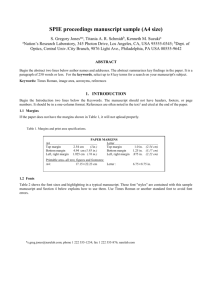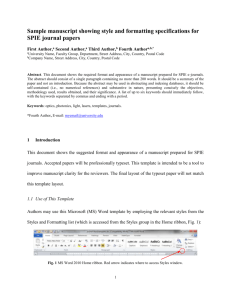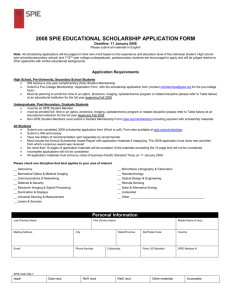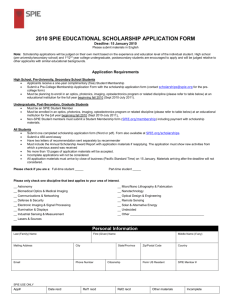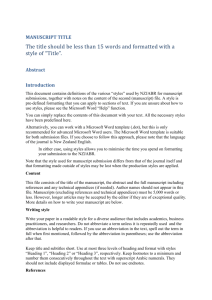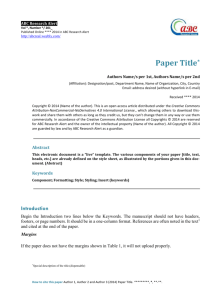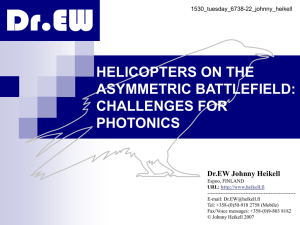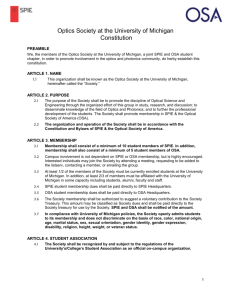Preformatted SPIE Template Styles
advertisement
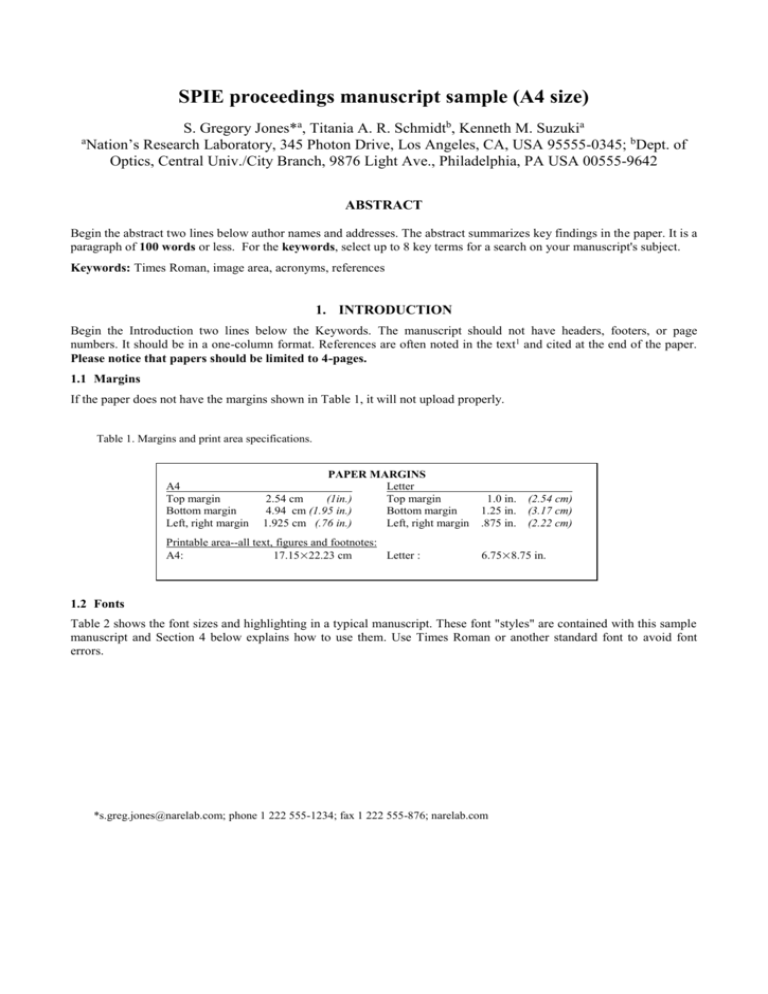
SPIE proceedings manuscript sample (A4 size) a S. Gregory Jones*a, Titania A. R. Schmidtb, Kenneth M. Suzukia Nation’s Research Laboratory, 345 Photon Drive, Los Angeles, CA, USA 95555-0345; bDept. of Optics, Central Univ./City Branch, 9876 Light Ave., Philadelphia, PA USA 00555-9642 ABSTRACT Begin the abstract two lines below author names and addresses. The abstract summarizes key findings in the paper. It is a paragraph of 100 words or less. For the keywords, select up to 8 key terms for a search on your manuscript's subject. Keywords: Times Roman, image area, acronyms, references 1. INTRODUCTION Begin the Introduction two lines below the Keywords. The manuscript should not have headers, footers, or page numbers. It should be in a one-column format. References are often noted in the text1 and cited at the end of the paper. Please notice that papers should be limited to 4-pages. 1.1 Margins If the paper does not have the margins shown in Table 1, it will not upload properly. Table 1. Margins and print area specifications. A4 Top margin Bottom margin Left, right margin PAPER MARGINS Letter 2.54 cm (1in.) Top margin 4.94 cm (1.95 in.) Bottom margin 1.925 cm (.76 in.) Left, right margin Printable area--all text, figures and footnotes: A4: 17.15×22.23 cm Letter : 1.0 in. (2.54 cm) 1.25 in. (3.17 cm) .875 in. (2.22 cm) 6.75×8.75 in. 1.2 Fonts Table 2 shows the font sizes and highlighting in a typical manuscript. These font "styles" are contained with this sample manuscript and Section 4 below explains how to use them. Use Times Roman or another standard font to avoid font errors. *s.greg.jones@narelab.com; phone 1 222 555-1234; fax 1 222 555-876; narelab.com Table 2. Manuscript font sizes and formatting. This Microsoft Word template includes these formats as automated "styles", which can be selected in the Format menu -- Styles and Formatting. (9pt) Preformatted SPIE Template Styles Manuscript component Description SPIE paper title 16 pt. bold, center SPIE authors/affiliations 12 pt., center Keywords: *Keywords* 10 pt., left justify SPIE ABSTRACT TITLE 11 PT. BOLD, center SPIE abstract body text 10 pt., justify SPIE SECTION HEADING 11 pt. BOLD, center, whole numbers 1.1 Heading 2, SPIE subsection heading SPIE body text 10 pt. bold, left justify, subsection numbers 10 pt., justify SPIE figure caption SPIE table caption SPIE footnote text 9 pt., justify below figure 9 pt., justify above figure 9 pt., justify, numbered REFERENCE HEADING 11 pt. BOLD, center 1. SPIE reference listing 10 pt., justify, numbered in brackets 2. FORMATTING OF MANUSCRIPT COMPONENTS 2.1 Title Center the paper title at the top of the page in 16-pt. bold. Only the first word, proper nouns, and acronyms are capitalized. Keep titles brief and descriptive. Spell out acronyms unless they are widely known. Avoid starting with articles or prepositions, e.g., “The study of … ,” or, “On the ….” 2.2 Author affiliations The author list is in 12-pt. regular, centered. Omit titles and degrees such as Dr., Prof., Ph.D., etc. The list of affiliations follows. Each author's affiliation should be clearly noted. 2.3 Section headings Section headings are 11-pt. bold capitals, centered. Sections numbers have whole numbers, e.g., 1, 2, 3… Don't number the "Acknowledgements" and "References." Headings often used are: 1. Introduction, 2. Methodology, 3. Data, 4. Results, and 5. Conclusions. 2.4 Subsection heading Subsection headings are left-justified, 10-pt. bold. Capitalize the first word, acronyms, and proper nouns. 2.5 Paragraphs Add a blank line above and below section headings and between paragraphs. Avoid headings or one-line paragraphs at the top or bottom of a page by using page breaks or extra blank lines. One method to preserve page breaks is to make the bottom margin a little larger than the specifications. Indentation is optional. This spacing is automatic if you are using the SPIE "section" styles in Word. 2.6 Text Text is 10 point and justified. Each sentence ends with a period and a single space before the next sentence. 2.7 Figures and captions Figures are centered. Use or insert .jpg, .tiff, or .gif illustrations instead of PowerPoint or graphic constructions. Captions go below figures. Indent 5 spaces from left margin and justify. Figure 1. Figure captions are indented 5 spaces and justified. If you are familiar with Word styles, you can insert a field code called Seq figure which automatically numbers your figures. 2.8 Tables and captions Tables are centered. The caption goes above the table. The caption text should indent 5 spaces from left margin and justify. Table examples are on page 1 and 2 and below. 3. MULTIMEDIA FIGURES – VIDEO AND AUDIO FILES Video and audio files can be included for publication. Table 3 lists the specifications for the mulitimedia files. Use a screenshot or another .jpg illustration for placement in the text. Use the file name to begin the caption. The text of the caption must end with the text "http://dx.doi.org/doi.number.goes.here" which tells the SPIE editor where to insert the hyperlink in the digital version of the manuscript. Here is a sample illustration and caption for a multimedia file: Video 2. A label of “Video/Audio 1, 2, …” should appear at the beginning of the caption to indicate to which multimedia file it is linked . Include this text at the end of the caption: http://dx.doi.org/doi.number.goes.here Table 3. Information on video and audio files that can accompany a manuscript submission. Item Video Audio File name Video1, video2, … Audio1, audio2, … Number of files 0-10 0-10 Size of each file max. 5 mb max. 5mb File types accepted .mpeg, .mov (Quicktime), (Windows Media Player) .wmv .wav, .mp3 4. MATHEMATICAL EQUATIONS Use common fonts like Times Roman in your math equations. A math reference in a paragraph sentence such as s is not numbered. The steps of a mathematical argument can be numbered using a right-aligned tab for clarity, for example α= b b 2ac 2o (1) and ρ= ( x x) 2 . (2) 5. USING THIS TEMPLATE AND ITS AUTOMATIC FORMATTING This document template and more information is available on SPIE.org: http://spie.org/x14101.xml or by emailing author_help@spie.org 5.1 View the pre-formatted styles To see the formats available with this manuscript, go to the Format menu and choose "Styles and Formatting". To view which style is being used in any part of this document, place your cursor on the line and look in the Styles and Formatting display. 5.2 Using SPIE styles To use this template in Microsoft Word: open this file and save it to a new file name. Type over the existing text with your paper. Alternately, you can delete all text, and select the SPIE style for each paragraph from the Styles and Formatting menu. 5.3 Notes on SPIE styles The styles listed in Table 2 automatically add extra spacing before and/or after paragraphs: SPIE title, SPIE authorsaffiliations, SPIE section heading, SPIE subsection heading, and SPIE body text. The 1.1 Heading 2 style automatically goes into the body text style after one paragraph return. REFERENCE LINKING SPIE is able to display the references section of your paper in the SPIE Digital Library, complete with links to referenced journal articles, proceedings papers, and books, when available. This added feature will bring more readers to your paper and improve the usefulness of the SPIE Digital Library for all researchers. Denote reference citations within the text of your paper by means of a superscript number. List references at the end of the paper in numerical order, and enclose the reference number in square brackets. Include the following information (as applicable). If you use this formatting, your references will link your manuscript to other research papers that are in the CrossRef system. Exact punctuation is required for the automated linking to be successful. book: [1] Booth, N. and Smith, A. S., [Infrared Detectors], Goodwin House Publishers, New York & Boston, 241-248 (1997). journal paper: [2] Davis, A. R., Bush, C., Harvey, J. C. and Foley, M. F., "Fresnel lenses in rear projection displays," SID Int. Symp. Digest Tech. Papers 32(1), 934-937 (2001). proceedings paper: [3] Van Derlofske, J. F., "Computer modeling of LED light pipe systems for uniform display illumination," Proc. SPIE 4445, 119-129 (2001). website: [4] Myhrvold, N., “Confessions of a cybershaman,” Slate, 12 June 1997, <http://www.slate.com/CriticalMass/97-06-12/CriticalMass.asp> (19 October 1997). www.optics4yurresearch.com/7752.html REFERENCES [1] Booth, N. and Smith, A. S., [Infrared Detectors], Goodwin House Publishers, New York & Boston, 241-248 (1997). [2] Davis, A. R., Bush, C., Harvey, J. C. and Foley, M. F., "Fresnel lenses in rear projection displays," SID Int. Symp. Digest Tech. Papers 32(1), 934-937 (2001). [3] Van Derlofske, J. F., "Computer modeling of LED light pipe systems for uniform display illumination," Proc. SPIE 4445, 119-129 (2001). [4] Myhrvold, N., “Confessions of a cybershaman,” Slate, 12 June 1997, <http://www.slate.com/CriticalMass/9706-12/CriticalMass.asp> (19 October 1997). www.optics4yurresearch.com/7752.html [5] Jones, C. J., Director, Miscellaneous Optics Corporation, interview, Sept. 23 2011 [6] FamilyName, GivenName Initial., "Title," Source, pg# (year).
